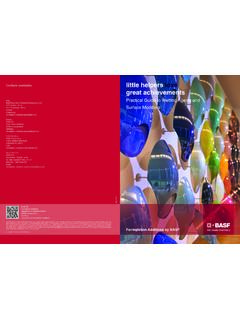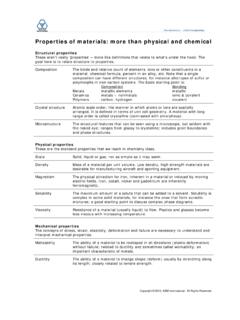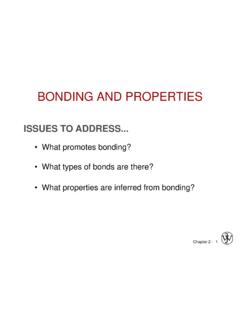Transcription of LABEL STOCK ADHESIVES - UPM Raflatac
1 Labeling a smarter futureFind the right solution for your brand at STOCK ADHESIVES2 ADHESIVE CLASSIFICATIONT here are a number of ways to classify or describe an adhesive. One is by chemical composition, such as acrylic-based polymers or rubber-based polymers. Another is by the carrier used in coating the adhesive, such as water-based, solvent-based, hotmelt or UV cross-linked. We also designate ADHESIVES by how they are used in the end-use application. CHEMICAL COMPOSITION Acrylic ADHESIVES are composed of a tacky synthetic polymer , typically made up of 2-ethylhexyl acrylate (EHA) and/or butyl acrylate. Therefore, they are naturally tacky and have very good chemical, heat and UV resistance. These ADHESIVES also tend to have lower migration than typical rubber-based alternatives.
2 Acrylic ADHESIVES can be coated as water-based emulsion, solvent-based or UV cured. Rubber-based ADHESIVES are typically composed of a synthetic rubber, such as styrene butadiene rubber (SBR), styrene isoprene styrene (SIS) or natural rubber. Unlike acrylic polymers, rubber-based ADHESIVES are not naturally tacky, so tackifiers must be added to give the base polymer those properties. Rubber-based ADHESIVES can be coated as a water-based adhesive, a hotmelt adhesive or a solvent adhesive. Rubber-based ADHESIVES tend to be less chemically-resistant to solvents and have less heat resistance. Hotmelt rubber-based ADHESIVES are especially sensitive to higher temperatures due to their coating method. About this bookUPM Raflatac LABEL STOCK ADHESIVES is your guide to making the right adhesive choice for a wide range of end-uses.
3 The following pages identify potential problems encountered with specific substrates and environmental conditions, and describe the composition and properties of a variety of ADHESIVES designed to solve those issues. All UPM Raflatac ADHESIVES are as environmentally-sound as possible, without compromising performance. If you have any questions, our experts are only a phone call or email away! Contact us at 1-866-294-8412 or email us at TYPES There are four typical types of carrier systems used in pressure sensitive LABEL applications: water-based (dispersion), solvent-based, hotmelt and UV acrylic. Water-based systems use water as the carrier, which is evaporated in the coating process, leaving only the adhesive polymer behind.
4 One example of this is the liquid white glue typically used by elementary school students. Water-based systems are by far the most common method for acrylic ADHESIVES , as they have the least environmental impact and offer the lowest manufacturing costs. Hotmelt ADHESIVES are 100 percent solids that are heated to a molten state to allow them to be coated. This means that there is no solvent present as part of the formulation. The material is tacky at room temperature, but as heat is applied it becomes viscous like a syrup that can then be coated. Rubber-based hotmelts tend to adhere very well to non-polar surfaces, such as HDPE, LDPE and waxy corrugated. These systems typically work very well in applications with high moisture or high condensation.
5 Hotmelts do not perform well in elevated temperatures. The material becomes softer as temperatures rise hence the coating method and loss of adhesion can occur. Most hotmelts are rubber-based, and therefore are not as resistant to solvents and UV exposure. Hotmelt coating is a fairly common method and has limited environmental impact. Solvent ADHESIVES use solvents to carry the polymer , and much like water-based systems, the solvent is evaporated or dried during the coating process. Solvent ADHESIVES can be easily cross-linked at different levels during the coating process. This capability makes them very versatile, as it can allow the adhesive to have enhanced heat and chemical resistance, or it can change the adhesion level of the base polymer altogether.
6 Solvent ADHESIVES are usually either acrylic or rubber-based and typically cost significantly more than hotmelts or water-based carrier ADHESIVES . UV cross-linkable ADHESIVES are a relatively new technology and are typically formulated to displace solvent-based technology. Most UV ADHESIVES are 100 percent solid acrylic ADHESIVES coated as a warm melt and cured by exposing the adhesive to UV radiation. They can also be modified to have very high initial tack, high temperature resistance or high chemical resistance, which gives this type of carrier system a very wide performance range. CLASSIFICATIONSA dhesives can also be classified according to the end-use or type of adhesion. Permanent ADHESIVES are designed to stay permanently on the labeling substrate in a variety of applications may call for a removable adhesive, so that the LABEL can be easily removed from the substrate.
7 Removability properties are strongly dependent upon the substrate and storage conditions. Washable ADHESIVES are permanent in nature but can be washed away when the LABEL is no longer needed. These types of labels are used on returnable packages that can be used several times, such as bottles or plastic OR FILM?UPM Raflatac offers a variety of ADHESIVES compatible with both paper and film face materials. PaperStandard permanent ADHESIVES for paper include RP51, RP54, RP48AT, RH09, RH23 and RR22. Other options include RP36TX and RH15. These ADHESIVES are commonly used with paper face materials to create labels for the following end--uses: food, logistics, retail, weigh scale, direct mail and charity, office, promotional and pharmaceuticals.
8 FilmStandard ADHESIVES in the film segment include RP37, which is ideal for home and personal care applications and when higher initial tack is required when compared to most general purpose film ADHESIVES . However, RP37 is not recommended on clear face materials where warm water resistance is required or on damp surfaces. RP74 adhesive is recommended for standard home, personal care and food package labeling and works well with thin film face materials. It offers excellent water resistance after application (24 72 hour dwell time) as well as good open time on adhesive is UPM Raflatac 's high-performing film adhesive for glass bottles in the beverage market. This adhesive offers excellent wet stick and passes the 72-hour ice bucket test.
9 4 FOOD LABELING Over 70% of the packaging business is food-related, and food labeling applications are some of the most diverse in the industry. These paper and film labels are expected to conform to a variety of packaging types including glass, plastics, metals, paper and corrugated fiberboard. They must provide eye-catching branding to motivate point-of-sale purchases; and communicate critical nutrition information, like product ingredients and sell-by dates. Clear labels for food packaging is one of the latest trends for displaying quality, freshness and outstanding shelf appeal, and ADHESIVES with optimal clarity are required in those applications. ADHESIVES in the food labeling segment may also provide exceptional performance in challenging environments, from cold, moist and greasy surfaces to freezing conditions.
10 Food packaging labels play an integral role in product safety. The majority of UPM Raflatac ADHESIVES meet the compositional requirements listed in FDA Indirect Food Additive regulation FDA 21 CFR ADHESIVES . HOME & PERSONAL CARE LABELINGHome and personal care labeling is one industry where it pays to put your best face forward. Consumers are attracted to strong brand imagery and squeezable packaging but expect labels to stick and stay. These products are often used in moist, wet and humid conditions over long periods of time, and they encounter a wide range of household chemicals. Squeezable and complex shaped containers demand higher adhesion to assure good LABEL performance. These types of bottles require a construction that pairs high adhesion with flexibility for maximum squeezability without the formation of wrinkles and creases.






